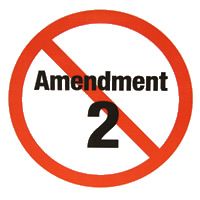
Twenty years ago, on May 20, 1996, a landmark victory was won at the United States Supreme Court in Romer v. Evans, the Amendment 2 case from Colorado, the single most positive Supreme Court ruling in the history of the gay rights movement up to that time. Roy Romer was the governor of Colorado, and Richard G. Evans was a gay man who worked for the Denver mayor’s office.
The ruling made clear that lesbians, gay men and bisexuals have the same right to seek government protection against discrimination in the U.S. as any other group of people. The decision marked a new level of legal respect for LGBTQ people and rejected the notion that it is legitimate for the government to discriminate against gay people based on moral objections to homosexuality.
Antigay forces in the early 1990s mounted voter initiatives at local and state levels to block and repeal the passage of laws and policies prohibiting discrimination based on sexual orientation. Amendment 2 was a statewide antigay initiative prohibiting all branches of government in Colorado from passing legislation or adopting policies prohibiting discrimination against LGBTQ people based on sexual orientation. The measure passed in 1992 by 53 percent of Colorado’s voters.
Working with the ACLU and the Colorado Legal Initiatives Project, Lambda Legal won preliminary court rulings that kept the measure from taking effect until their lawsuit was resolved. The case reached the Supreme Court, which struck down Amendment 2 in a 6-3 ruling based on the Equal Protection clause of the federal Constitution. In declaring Amendment 2 unconstitutional, the Court made clear that antigay sentiment does not justify governmental discrimination and shattered the “special rights” rhetoric of those who oppose equal treatment for LGBTQ people.
“[Amendment 2] is at once too narrow and too broad,” said Justice Anthony Kennedy in his opinion. “It identifies persons by a single trait and then denies them protection across the board. The resulting disqualification of a class of persons from the right to seek specific protection from the law is unprecedented in our jurisprudence.” The three dissenting votes were Chief Justice William H. Rehnquist, Justices Antonin Scalia and Clarence Thomas.
Among the plaintiffs in the case were lesbian feminist tennis star Martina Navratilova, the Boulder Valley School District RE-2, the City and County of Denver, the City of Boulder, and the City of Aspen.
This case led the way for numerous additional states and local governments to ban such discrimination by statute, ordinance, directive or policy.
The decision in Romer set the stage for Lawrence v. Texas (2003), where the Court overruled its earlier decision in Bowers v. Hardwick (1986), which held that laws criminalizing sodomy were constitutional. It also paved the way for the Supreme Court ruling striking down Section 3 of the Defense of Marriage Act in United States v. Windsor (2013), and for the Court’s ruling striking down state bans on same-sex marriage in Obergefell v. Hodges (2015). Justice Kennedy authored all four of these post-Bowers opinions.
Still, antigay forces, such as legislatures in GOP-dominated states, continue to invent every manner of nuisance laws to persecute LGBTQ people, even when majorities of their constituents are in favor of equal treatment under the law. Many of the most recent attacks on the LGBTQ community have come in the form of “religious freedom” protection, or the purported defense of women’s rights (to privacy in bathrooms, for example). In time these measures too will be declared unconstitutional, but in the meantime they serve as a powerful wedge issue to drive conservative voters to the polls and elect right-wingers at all levels of government.
Adapted from Lambda Legal, Wikipedia and other sources.
Photo: Lambda Legal












Comments